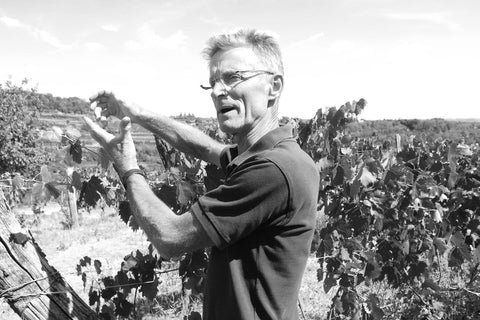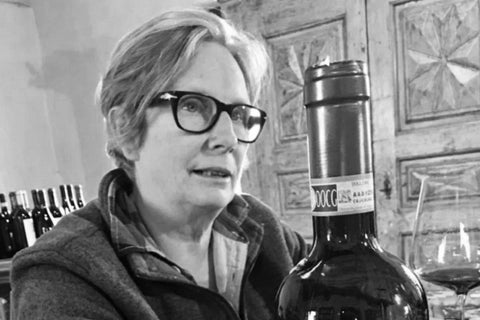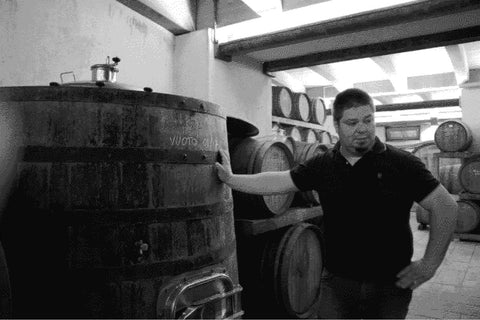Angiolino, a quick and dirty definition of natural wine?
Natural wine is simply a wine that is produced without any additives both in the vineyard and in the cellar. It’s a product and child of the land, transformed by culture, experience and wisdom. The human element is here considered a vital element and part of nature, as well as of terroir. I’d like to emphasize again this factor since there is still this widespread and absurd misconception that “natural wine” means “wine that makes itself.”
When did you start making wine, intended as the first officially bottled vintage, and what was the story that took you there?
My very first vintage was way back in 1988 but everything started with a dream that I had already been nurturing for many years, which I then manage to make come true through endless hard work and dedication, both mine and of the whole family. Initially I worked with a winemaking consultant and I was extremely doubtful, to say the least, about the wines that he was pushing me to make. That’s why, during the early 1990s, I started to emerge from my whole and look around the world surrounding me. I headed for Friuli’s Collio and started learning a new, but actually quite old, and revolutionary kind of farming and winemaking from now legendary vigneron Gravner. This was along a small but tight-knit group of friends/colleagues such as Stanko Radikon and Dario Princic. From this point onwards I began to find my way of winemaking and to gradually eliminate additives, filtrations, and all other barriers standing between my wines and my terroir’s true character. Back then I was farming alone my 5 hectares; it wasn’t easy being understood and appreciated, I had to fight very hard for it. From the 1990’s onwards our winery gradually began to grow and is now made up of 18 hectares. Today my sons are also actively involved in managing the vineyards and cellar. We work predominantly with Garganega, our most typical local variety, not very well known but incredibly expressive and versatile.
You’ve been one of the true pioneers of natural wine, making these uniques and real wines while most of the world was enamored with chemical oak bombs. You’ve therefore witnessed something of a paradigm shift: from when you were maybe considered insane to the growing popularity of natural wine in most markets. How did you see the perception of natural wine change in different markets, both when it comes to wine professionals and wine lovers?
I think that, compared to the 90s and early-mid 2000s, there is a lot more attention focusing on quality wines, as well as a will to more deeply understand it. This caused somewhat of a rejuvenation of the sector, with wine consumption generally seen as less elitist and snobbish, especially among end users. This cannot be but be a positive development. Wine professionals, especially younger ones, are today more and more competent and keen to delve deeper into all themes related to “how” a wine is produced rather than the style or the celebrity status of the producer. I firmly believe that any professional who’s not willing to grow and develop in this direction is bound to have low credibility, and most of the new generations of sommeliers understand this.
How do you see the role of skin contact in white wines: does it exalt the grape and terroir or does it risk to obfuscate it?
I’ve never been a big fan of the term “orange wine”, I feel that it overly focuses on a technique which risks becoming a style, too often penalizing the real character and territoriality of a wine. I do believe that maceration can be very useful as a winemaking tool, but it needs to be carefully understood and calibrated depending on the grape variety and vintage. Otherwise the risk is that it can become an homologating factor like the use of barriques or selected yeasts. The aim of skin contact in my view is that of improving the fermentative process, extract some tannins and contribute to a wine’s fuller structure and extended aging potential. It shouldn’t become the single most characterising element.
Palate and sustainability, or maybe palate vs sustainability? Do they always go hand in hand? And if sometimes they don’t, which should be the ultimate parameter in judging a wine?
As the years go by I become more and more convinced that these two can and should walk together. In the growing microcosm of natural wines, especially since it takes much better craft to work without chemical shortcuts, mistakes and accidents in the winemaking process can happen. This is especially true in difficult vintages. But these occurrences must be the exception and not be repeated constantly, to the point that they can become a winery’s stylistic signature. Wine defects are the result of mistakes of the vigneron, they are most definitely not the consequence of natural farming and winemaking. That’s basically why I absolutely agree with those that argue that, in the end, the palate must be king.
Is natural wine a fleeting fad or is it here to stay, bound to become more and more mainstream converting an increasing number of non-believers?
I strongly hope the latter will come to pass, and partially it’s a process that it’s already begun. The movement’s growth has been slow but it has both accelerated and shown remarkable resilience. This is a strong positive signal. I also believe, however, that the vignerons must ensure that consistence in quality, already very high today, keeps growing and that defective wines, already rare, become even more so. This is the only way to avoid and fight off attacks from the the industrial/conventional wine sector.
As one of the founding fathers of Vinnatur, arguably the largest and most respected natural wine association in the world, what are your take and perspective on the debate for the need of a EU-wide natural wine official legislation?
Personally I’m a strong believer in the need for a future legislation on natural wine, but I also believe that we’re not quite there yet. The context is not yet sufficiently mature nor ready. Every association at the moment has different parameters, although they do differ marginally, and it would be rather hard to present a united front to the EU legislator. Vinnatur has been analizing members’ sample wines for pesticides for now 14 years. The organic certification is certainly not enough for us, we created a specific charter with clear and verifiable rules and extremely strict limits for maximum total SO2. Furthermore, Vinnatur stands out among the various associations for its considerable investments in scientific experimentation and research both in the vineyard and in the cellar. All of our revenues originated from fairs, tastings and events are re-invested in continuously improving our member wineries’ knowledge and education, also through constant interactions with a wide variety of research institutes.
What does the future hold for the natural wine movement?
This might sound a bit repetitive but I believe in the utmost importance of a growing dialogue and interaction among the different natural wine associations. This is an invaluable tool in protecting the natural wine world from the insidious attacks of the conventional wine world. Attacks that can be of the frontal kind or, more often than not, can take the shape of appropriation of our ideals for purely financial aims. Insofar as inter-association ferment something is already brewing ebtween us and the natural vigneron association Vi.Te. (Vignaioli e Territorio), so there might be some surprises in store during the upcoming natural wine fairs in the Spring.



